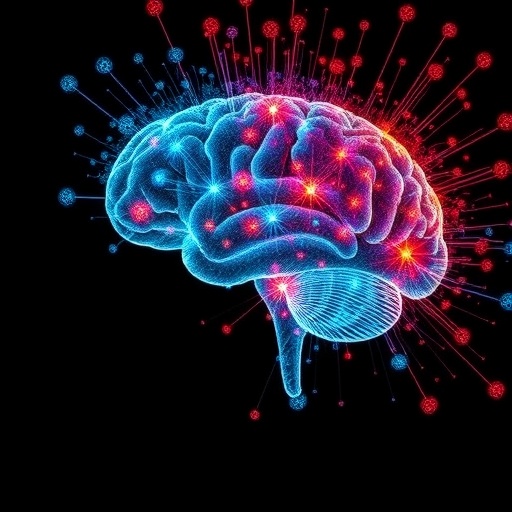In a groundbreaking study published in Nature Human Behavior, researchers have shed light on the intricate and often overlooked dynamics of spontaneous brain activity, revealing how these processes underpin individual differences in behavior and cognitive abilities. This research emphasizes the importance of exploring not only inter-regional couplings within the brain but also the nuances of intra-regional dynamics, which have largely remained in the shadows of neuroimaging investigations. The findings are pivotal, as they highlight new avenues for understanding the neural correlates of behavior across different ages and populations.
Utilizing data from an extensive pool of 30,148 participants aged between 8 and 82 years, the study meticulously analyzed resting-state haemodynamic signals acquired from 271 distinct brain regions. With a focus on extracting approximately 5,000 time-series features, the researchers sought to create a comprehensive framework that captures the richness of intra-regional brain dynamics. This robust dataset allows for an unprecedented exploration of the relationships between brain activity patterns and individual behavioral traits, ultimately contributing to the growing field of brain-wide association studies.
One of the most fascinating outcomes of this research is the identification of a unique subset of brain dynamics that function as an individual-specific ‘barcode.’ This barcode represents an intricate signature of brain activity, capturing multifaceted dimensions that reflect the inherent variability among individuals. By establishing this individualized framework, the researchers illustrate how subtle differences in brain dynamics can lead to significant behavioral outcomes, which are stable across various datasets and populations.
Furthermore, the study revealed a compelling link between nonlinear autocorrelations present in unimodal brain regions and specific substance use traits. This suggests a predictive element whereby distinct brain activity patterns may predispose individuals to certain behaviors or tendencies, such as drug or alcohol use. It’s an exciting proposition that opens up new discussions regarding prevention and treatment strategies tailored to individual neural profiles, potentially revolutionizing how we approach substance-related issues.
Additionally, the research team discovered that random walk dynamics in higher-order brain networks correlate with general cognitive abilities. This connection raises intriguing questions about the fundamental nature of thought processes and cognitive functioning. By elucidating these relationships, the findings bridge a significant gap in our understanding of how brain function translates to cognition and behavior, grounding these complex phenomena in observable neural dynamics.
The clinical implications of this study are manifold. The identification of brain characteristics that correlate with specific behavioral traits can pave the way for more personalized interventions in education and mental health treatment. For example, understanding how spontaneous brain activity in different age groups influences cognitive performance could inform educational strategies, tailoring learning environments to better suit individual needs and capacities.
As the study emphasizes, these brain-behavior associations are remarkably generalizable across life stages. The researchers noted that while substance use patterns exhibited age-specific variations, cognitive functions displayed consistent trends across age groups. This highlights a unique aspect of human development; while our experiences and choices shape our behaviors, the underlying neural mechanisms are often steadfast, suggesting a foundational architecture that remains resilient despite environmental changes.
However, it is important to temper our enthusiasm with a balanced perspective. The complexity of the brain means that while these associations are significant, they are not deterministic. This nuance is crucial for understanding that individual differences in behavior are not solely the product of neural signatures. Instead, they are interwoven with a tapestry of genetic, environmental, and experiential factors that together shape who we are.
Beyond the immediate implications for psychology and neuroscience, this research carries potential ramifications for the broader societal context. As we begin to decipher the intricate relationship between brain dynamics and behavior, the possibility of fostering greater understanding and empathy within educational systems, workplaces, and social interactions comes to the forefront. Insight into why individuals behave differently could lead to more inclusive environments that accommodate diverse cognitive profiles and behavioral expressions.
The comprehensive nature of the study underscores the value of longitudinal and large-scale neuroimaging research. Investigating intra-regional dynamics across diverse populations not only enriches our understanding of human behavior but also offers a platform for continuous exploration. Future studies can expand on these findings, investigating how these brain activity patterns evolve with age and correlate with various life experiences, including trauma, education, and social interactions.
In conclusion, this pioneering research marks a significant step forward in the quest to unravel the neural underpinnings of behavior. The work fundamentally reshapes our understanding of how individual differences manifest through brain activity, emphasizing the nuances of intra-regional dynamics that have previously been overlooked. The emerging picture is one where the brain is not merely a static repository of information but a dynamically operating entity, continuously shaped by both intrinsic and extrinsic influences—a realization that offers hope for tailored interventions that could better serve individuals across the lifespan.
In a world that increasingly relies on data and personalization, the findings from this study serve as a catalyst for further inquiry. From improving educational outcomes to enhancing mental health interventions, the implications are as vast as they are exciting. As we continue to explore the depths of the human brain, one thing remains clear: understanding our neural profiles is not just a scientific endeavor; it is a vital journey toward unlocking the full potential of human behavior.
By shedding light on these intricate dynamics, this research paves the way for future studies that could delve deeper into the vast ocean of brain-behavior relationships, propelling us toward a more comprehensive comprehension of what it means to be human.
Subject of Research: Spontaneous brain activity and its correlation with individual behavioral traits.
Article Title: Spontaneous brain regional dynamics contribute to generalizable brain–behaviour associations.
Article References:
Tian, X., Peng, Y., Liu, S. et al. Spontaneous brain regional dynamics contribute to generalizable brain–behaviour associations.
Nat Hum Behav (2025). https://doi.org/10.1038/s41562-025-02332-0
Image Credits: AI Generated
DOI: 10.1038/s41562-025-02332-0
Keywords: brain dynamics, individual differences, neuroimaging, behavior, cognitive abilities.




